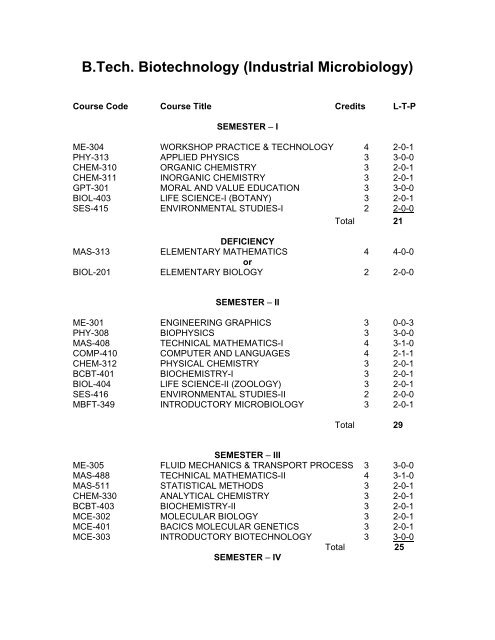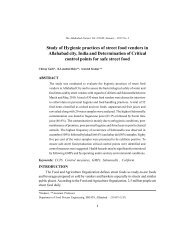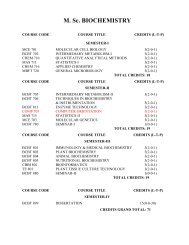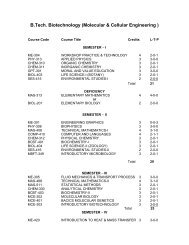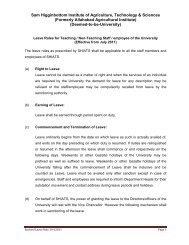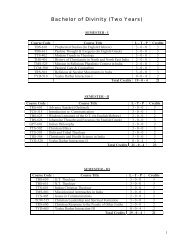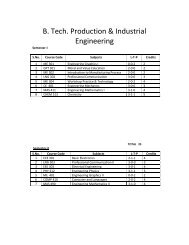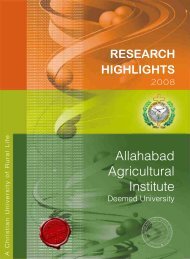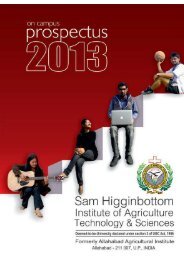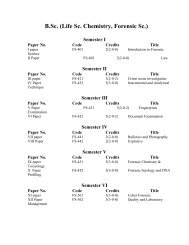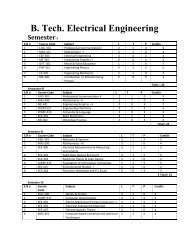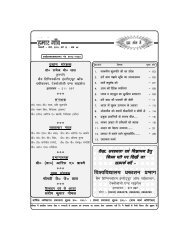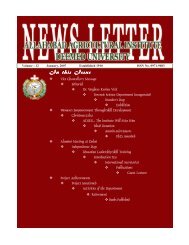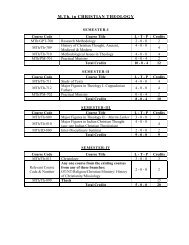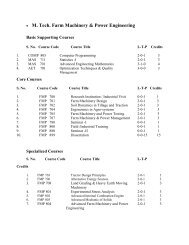B.Tech. Biotechnology (Industrial Microbiology) - Shiats.edu.in
B.Tech. Biotechnology (Industrial Microbiology) - Shiats.edu.in
B.Tech. Biotechnology (Industrial Microbiology) - Shiats.edu.in
You also want an ePaper? Increase the reach of your titles
YUMPU automatically turns print PDFs into web optimized ePapers that Google loves.
B.<strong>Tech</strong>. <strong>Biotechnology</strong> (<strong>Industrial</strong> <strong>Microbiology</strong>)<br />
Course Code Course Title Credits L-T-P<br />
SEMESTER – I<br />
ME-304 WORKSHOP PRACTICE & TECHNOLOGY 4 2-0-1<br />
PHY-313 APPLIED PHYSICS 3 3-0-0<br />
CHEM-310 ORGANIC CHEMISTRY 3 2-0-1<br />
CHEM-311 INORGANIC CHEMISTRY 3 2-0-1<br />
GPT-301 MORAL AND VALUE EDUCATION 3 3-0-0<br />
BIOL-403 LIFE SCIENCE-I (BOTANY) 3 2-0-1<br />
SES-415 ENVIRONMENTAL STUDIES-I 2 2-0-0<br />
Total 21<br />
DEFICIENCY<br />
MAS-313 ELEMENTARY MATHEMATICS 4 4-0-0<br />
or<br />
BIOL-201 ELEMENTARY BIOLOGY 2 2-0-0<br />
SEMESTER – II<br />
ME-301 ENGINEERING GRAPHICS 3 0-0-3<br />
PHY-308 BIOPHYSICS 3 3-0-0<br />
MAS-408 TECHNICAL MATHEMATICS-I 4 3-1-0<br />
COMP-410 COMPUTER AND LANGUAGES 4 2-1-1<br />
CHEM-312 PHYSICAL CHEMISTRY 3 2-0-1<br />
BCBT-401 BIOCHEMISTRY-I 3 2-0-1<br />
BIOL-404 LIFE SCIENCE-II (ZOOLOGY) 3 2-0-1<br />
SES-416 ENVIRONMENTAL STUDIES-II 2 2-0-0<br />
MBFT-349 INTRODUCTORY MICROBIOLOGY 3 2-0-1<br />
Total 29<br />
SEMESTER – III<br />
ME-305 FLUID MECHANICS & TRANSPORT PROCESS 3 3-0-0<br />
MAS-488 TECHNICAL MATHEMATICS-II 4 3-1-0<br />
MAS-511 STATISTICAL METHODS 3 2-0-1<br />
CHEM-330 ANALYTICAL CHEMISTRY 3 2-0-1<br />
BCBT-403 BIOCHEMISTRY-II 3 2-0-1<br />
MCE-302 MOLECULAR BIOLOGY 3 2-0-1<br />
MCE-401 BACICS MOLECULAR GENETICS 3 2-0-1<br />
MCE-303 INTRODUCTORY BIOTECHNOLOGY 3 3-0-0<br />
Total 25<br />
SEMESTER – IV
ME-420 INTRODUCTION TO HEAT & MASS TRANSFER 3 3-0-0<br />
EEE-301 ELECTRICAL ENGINEERING 4 2-1-1<br />
COMP-510 FOUNDATION OF INFORMATION TECHNOLOGY 4 2-1-1<br />
BCBT 408 CHEMICAL THERMODYNAMICS 3 3-0-0<br />
BCBT-404 ENZYMOLOGY & ENZYME TECHNOLOGY 3 2-0-1<br />
GPB-412 GENETICS 3 2-0-1<br />
MCE-406 MOLECULAR BIOLOGY TECHNIQUES 3 2-0-1<br />
& INSTRUMENTATION<br />
MCE-402 INTRODUCTION TO PLANT BIOTECHNOLOGY 3 2-0-1<br />
Total 26<br />
JSBB-400 TRAINING-I 1 0-0-2<br />
SEMESTER – V<br />
ECE-430 ELECTRONIC MEASUREMENT 3 2-0-1<br />
& INSTRUMENTATION<br />
CBBI-502 CONCEPTS OF BIOINFORMATICS 3 2-0-1<br />
BCBT-407 CHEMICAL ENGINEERING 3 3-0-0<br />
LNG-304 PROFESSIONAL COMMUNICATION 3 3-0-0<br />
& TECHNICAL WRITING<br />
BCBT-405 BASIC IMMUNOLOGY 3 2-0-1<br />
MCE-403<br />
INTRODUCTION TO ENVIRONMENTAL<br />
BIOTECHNOLOGY 3 2-0-1<br />
MBFT-452 MICROBIAL METABOLISM 2 2-0-0<br />
MBFT-453 PRINCIPLES OF MICROBIAL GENETICS 2 2-0-0<br />
JSBB -400 TRAINING-I EVALUATION 1 0-0-1<br />
Total 23<br />
SEMESTER – VI<br />
BAM-502 MARKETING & MANAGEMENT 3 3-0-0<br />
OF BIOTECHNOLOGY PRODUCTS<br />
TIEG-503 CONCEPTS OF IN VITRO CULTURE 3 2-0-1<br />
MCE-404 INTRODUCTION TO ANIMAL BIOTECHNOLOGY 3 2-0-1<br />
MCE-501 BIOSAFETY, BIOETHICS & IPR ISSUES 3 3-0-0<br />
MCE-502 RECOMBINANT DNA TECHNOLOGY [MCE] 3 2-0-1<br />
MBFT-507 MICROBIAL BIOTECHNOLOGY [IM] 3 2-0-1<br />
BCBT-501 BIOCHEMICAL ENGINEERING [BT] 3 2-0-1<br />
JSBB-488 SEMINAR-I 1 0-0-1<br />
Total 16<br />
JSBB-500 TRAINING-II 1 0-0-2<br />
SEMESTER – VII<br />
MOLECULAR & CELLULAR ENGINEERING (MCE)
MCE-601 MOLECULAR BREEDING 3 2-0-1<br />
MCE-602 GENOMICS 3 3-0-0<br />
MCE-603 GENETICALLY MODIFIED FOODS 3 3-0-0<br />
MCE-604 GENE CLONING AND GENE THERAPY 2 2-0-0<br />
CBBI-601 STRUCTURAL BIOINFORMATICS 2 1-0-1<br />
JSBB-589 SEMINAR-II 1 0-0-1<br />
JSBB-500 TRAINING-II EVALUATION 1 0-0-1<br />
Total 15<br />
INDUSTRIAL MICROBIOLOGY (IM)<br />
MBFT-601 FERMENTATION TECHNOLOGY 3 2-0-1<br />
MBFT-612 MICROBIAL PROCESS ENGINEERING 3 2-0-1<br />
MBFT-603 CLINICAL MICROBIOLOGY 2 2-0-0<br />
MBFT-604 MICROBIAL ENZYME TECHNOLOGY 3 2-0-1<br />
MBFT-605 MICROBIAL TECHNOLOGY IN FOOD INDUSTRY3 2-0-0<br />
JSBB-589 SEMINAR-II 1 0-0-1<br />
JSBB-500 TRAINING-II EVALUATION 1 0-0-1<br />
Total 15<br />
BIOPROCESS TECHNOLOGY (BT)<br />
BCBT-601 BIOPROCESS ENGINEERING & 3 2-0-1<br />
DOWNSTREAM PROCESSING<br />
BCBT-602<br />
IMMUNOLOGY: VACCINE ANDTRANSPLANTATION HNOLOGY<br />
3 2-0-1<br />
BCBT-603 MEDICAL AND MOLECULAR DIAGNOSTICS2 1-0-1<br />
BCBT-606<br />
CLINICAL AND PHYSIOLOGICAL<br />
BIOCHEMISTRY 3 2-0-1<br />
CHEM-605 BIOPOLYMER TECHNOLOGY 2 2-0-0<br />
JSBB-589 SEMINAR-II 1 1-0-0<br />
JSBB-500 TRAINING-II EVALUATION 1 0-0-1<br />
Total 15<br />
SEMESTER – VIII<br />
JSBB-699 PROJECT (GE/MT/BT) 9 0-0-18
B. <strong>Tech</strong>. <strong>Biotechnology</strong> (MCE/IM/BPT) - 1 st Semester<br />
Admission year-2009<br />
ME-304 WORKSHOP PRACTICE & TECHNOLOGY 4(2-0-2)<br />
Introduction to eng<strong>in</strong>eer<strong>in</strong>g materials and its classification, metals and its<br />
classification – ferrous and non-ferrous metals and its alloys, cast iron steel and<br />
alloy steel<br />
Brief <strong>in</strong>troduction – description and uses of hand tools used <strong>in</strong> carpentry shop,<br />
fitt<strong>in</strong>g shop, sheet metal work, smithy shop, plumb<strong>in</strong>g shop, weld<strong>in</strong>g shop.<br />
Weld<strong>in</strong>g –<strong>in</strong>troduction to weld<strong>in</strong>g and its classification, gas weld<strong>in</strong>g, electric<br />
weld<strong>in</strong>g, solder<strong>in</strong>g and bras<strong>in</strong>g<br />
Various types of fasteners and fasten<strong>in</strong>g devices, threads, term<strong>in</strong>ology of<br />
threads, various forms of threads. Properties of eng<strong>in</strong>eer<strong>in</strong>g materialsmechanical<br />
properties – strength elasticity, stiffness, plasticity, malleability,<br />
ductility, brittleness, toughness, hardness, impact strength , fatigue and creep<br />
Practical<br />
1. Carpentry shop, - simple job on vertical and horizontal saw<strong>in</strong>g , plann<strong>in</strong>g<br />
and slot mak<strong>in</strong>g <strong>in</strong> wood , (ii) tomake t- lap jo<strong>in</strong>t<br />
2. Smithy shop – to make o- r<strong>in</strong>g from a given rod (ii) to prepare s- hook<br />
3. Fitt<strong>in</strong>g shop –(i) simple exercise on fil<strong>in</strong>g, v- groove and vertyical saw<strong>in</strong>g<br />
(ii) to make square from given piece of mild steel by fil<strong>in</strong>g and hack saw<strong>in</strong>g<br />
4. Weld<strong>in</strong>g shop –(i) to makle butt weld of two given mild steel pieces (ii) to<br />
make lab weld of two given pieces (iii) solder<strong>in</strong>g and braz<strong>in</strong>g practices<br />
5. Sheet b metal shop –(I) to make book stand from given piece of sheet<br />
metal of 18 SWG<br />
6. Introduction of lathi mach<strong>in</strong>e show<strong>in</strong>g various parts.<br />
PHY-313 APPLIED PHYSICS 3(3-0-0)<br />
Units and measurements, dimensions and dimensional analysis<br />
Speed, velocity, acceleration, momentum, impulse, torque, k<strong>in</strong>ematics <strong>in</strong> one,<br />
two and three dimensions.
Newton’s law of motion, conservation of energy and l<strong>in</strong>ear momentum, weight<br />
and mass of body, Newton’s law of universal gravitation, satellite and<br />
weightlessness, Keplers law of planetary motion, types of force <strong>in</strong> nature.<br />
Equilibrium and elasticity, stress, stra<strong>in</strong>, hookes law elastic limit<br />
Mach<strong>in</strong>es and their pr<strong>in</strong>ciple, efficiency, mechanical advantage, velocity ratio,<br />
relationship between efficiency, mechanical advantage and velocity ratio , levers<br />
and their k<strong>in</strong>ds .<br />
Pressure <strong>in</strong> fluids and their laws, Pascals law, atmospheric pressure, gauge<br />
press, measurement of press, simple barometer, buoyancy and Archimedes<br />
pr<strong>in</strong>ciple, pr<strong>in</strong>ciple of floatation and it has applications. hydrometer and<br />
lactometer.<br />
Surface tension, capillary, equation of cont<strong>in</strong>uity, bernoullis equation, viscosity.<br />
Thermometry, relationship between the scales of temperature, absolute scale of<br />
temperature and cl<strong>in</strong>ical thermometer, specific heat, latent, conduction,<br />
conviction, radiation<br />
Rectil<strong>in</strong>ear propagation and reflection of light, formation of image of a po<strong>in</strong>t object<br />
by a plane mirrors, colours<br />
Sound, pitch, frequency, wavelength, velocity of sound echoes<br />
Electricity, simple cell, relation ship between current charge, potential, oms law<br />
resistance, series and parellel comb<strong>in</strong>ation<br />
Electrical power, watt and KWH, household electricity.<br />
CHEM-310 ORGANIC CHEMISTRY 3(2-0-1)<br />
UNIT I: chemistry of carbohydrates<br />
UNIT II: am<strong>in</strong>o acid and prote<strong>in</strong>
UNIT III: Benzene and its homologous, structure of benzene, aroma,<br />
nomenclature and aromatic compounds<br />
UNITIV: General <strong>in</strong>troduction of alkaloids<br />
UNITV: General <strong>in</strong>troduction of terpenes<br />
UNIT VI: <strong>in</strong>troduction to analytical chemistry and its branches<br />
UNITVII: General pr<strong>in</strong>ciples of analytical chemistry, volumetric analysis, concept<br />
of gram equivalents and method of express<strong>in</strong>g concentration of solution,<br />
preparation of primary and secondary standard solutions. Neutralization (acid –<br />
base), titration permagnometry, gravimetric analysis: pr<strong>in</strong>ciples of methodology<br />
estimate of calcium<br />
UNIT VIII thermometric analysis the gravimetric analysis, types, <strong>in</strong>strumentation,<br />
application<br />
UNITIX Polarimetry<br />
UNIT X Potentiometric titration, electrode system, ion selective membrane<br />
electrodes, application of potentiometric titrations<br />
PRACTICALS<br />
1. Qualitative analysis of organic compounds<br />
2. Volumetric determ<strong>in</strong>ation of Fe by KMnO 4 solution<br />
3. Polarimetric analysis<br />
4. Estimation of prote<strong>in</strong> by kjeldal method<br />
5. Estimation of calcium volumetrically.<br />
CHEM-311 INORGANIC CHEMISTRY 3(2-0-1)<br />
Periodic table: Mendleef periodic table, modern periodic table and table. Long<br />
and extended form of periodic table, its ma<strong>in</strong> features, merits and demerits.<br />
Periodic properties:
Atomic and ionic radii: classification of atomic radii (1) covalent radii (2) metallic<br />
radii (3) vander-waal radii, ionic radii. Classification of ionic radii (1) size of<br />
anions, size of cations, crystal coord<strong>in</strong>ation number, radius ratio, size of anions,<br />
factors <strong>in</strong>fluenz<strong>in</strong>g magnitude of ionic radii. Periodic variation of atomic and ionic<br />
radii.<br />
Ionization energy: <strong>in</strong>troduction, successive ionization energies. Factors<br />
<strong>in</strong>fluenz<strong>in</strong>g ionization energy (nuclear charge, size of atom, ion. shield<strong>in</strong>g<br />
effective nuclear charge, pr<strong>in</strong>cipal quantum number, half and full filled orbitals)<br />
trend of ionization energy <strong>in</strong> the periodic table<br />
Electronic aff<strong>in</strong>ity: first and second electron aff<strong>in</strong>ity. Factors effect<strong>in</strong>g magnitute<br />
of electron aff<strong>in</strong>ity. Periodic variation<br />
Radioactivity: <strong>in</strong>troduction of radioactivity, radioactive emmision ( alpla ,beta<br />
and gamma rays ). Half-life period, average life period, radioactive equilibrium.<br />
Group displacement law, atomatic and <strong>in</strong>duced radioactivity.<br />
Nuclear chemistry: nuclear fusion and nuclear fission reactions.<br />
Mass defect, b<strong>in</strong>d<strong>in</strong>g energy.<br />
GPT-301 MORAL AND VALUE EDUCATION 3(3-0-0)<br />
My country and my people, the many Indians, be<strong>in</strong>g and becom<strong>in</strong>g Indian,<br />
nationalism and <strong>in</strong>ternationalism<br />
Some life issues – love, sex and marriage, men and money – value of time,<br />
mean<strong>in</strong>g of work, human communication, human suffer<strong>in</strong>g, addition, ecology,<br />
women issues
Understand<strong>in</strong>g ones neighbor, neighborhood groups: their structure and their<br />
functions patterns of social <strong>in</strong>teractions of group dynamics. Preparation for a<br />
career, choice of vocation, motivation of study and research, and the present<br />
<strong>edu</strong>cational system: curricu8lam and syllabus, teach<strong>in</strong>g methods, exam<strong>in</strong>ation<br />
and work experience<br />
Def<strong>in</strong>ition of value <strong>edu</strong>cation, moral and ethics, laws and morale based on Ten<br />
Commandments and two great commandments<br />
Discovery of self, self – awareness, growth of <strong>in</strong>tellect – mans spiritual life<br />
emotions, will respect the rights of life, liberty, property, truth reputation<br />
S<strong>in</strong>, orig<strong>in</strong> of s<strong>in</strong>, manifestation of s<strong>in</strong>, the result of s<strong>in</strong>, the remedy of s<strong>in</strong>, s<strong>in</strong> as<br />
an act, s<strong>in</strong> as a state, s<strong>in</strong> as a nature.<br />
BIOL- 403 LIFE SCIENCE-I 3(2-0-1)<br />
1. Orig<strong>in</strong> of Life: History of earth, theories of orig<strong>in</strong> of life nature of the earliest<br />
organism.<br />
2. Varieties of Life: Classification, Five k<strong>in</strong>gdoms, viruses (TMV, HIV,<br />
bacteriophage), Prokaryotes (Bacteria-cell structure, nutrition, reproduction),<br />
Proyista,fungi,Plantae and animalia.<br />
3. Chemicals of life: (Biomolecules)-Carbohydrates, lipids am<strong>in</strong>o acids,<br />
prote<strong>in</strong>s, nucleic acids, identification of biomolecules <strong>in</strong> tissues.<br />
4. Histology: Meristems (apical, <strong>in</strong>tercalary, lateral) and their function simple<br />
tissues (parenchyma, collenchyma, sclerenchyma) Complex tissue(xylem and<br />
phloem); Tissue systems (epidermal, ground, vascular); primary body and<br />
growth(root,stem and leaf); secondary growth.<br />
Animal Epithelial tissue, connective tissue, muscle tissue and nervous tissue and<br />
their function <strong>in</strong> body.<br />
5.Nutrition: Autotophic(photosynthesis) Pigment systems, Chloroplast, light<br />
absorption by chlorophyll and transfer of energy, two pigment systems,<br />
photosynthetic unit, phosphorylation and electron transfer system, Calv<strong>in</strong>-Benson<br />
Cycle(C3), Hatch Slack Pathway(C4), Crassulacan Acid Metabolism(CAM),<br />
factors affect<strong>in</strong>g photosynthesis; M<strong>in</strong>eral nutrition <strong>in</strong> plants.
Heterotrophic-Forms of heterotrophic nutrition, elementary canal <strong>in</strong> Humans,<br />
nervous and hormonal control of digestive systems, fate of absorbed food<br />
materials; Nutrition <strong>in</strong> humans, Reference values.<br />
6.Energy Utilization: (Respiration) –Structure of mitochondria, cellular<br />
respiration, relationship of carbohydrate metabolism to other compounds,<br />
Glycolysis, fermentation, formation of acrtyl co-A, Kreb cycle, Electron Transport<br />
System and Oxidative Phosphorylation, ATP, factors affect<strong>in</strong>g respiration.<br />
7.Transport : Plant water relationship Properties of watwer diffusion, osmosis,<br />
imbibitions movement of water <strong>in</strong> flower<strong>in</strong>g plants, uptake of water by roots,<br />
ascent of water <strong>in</strong> xylem. Apoplast, symplast theory, transpiration structure of leal<br />
and stomata <strong>in</strong> plants open<strong>in</strong>g and clos<strong>in</strong>g mechanism of stomata factors<br />
affect<strong>in</strong>g transpiration, significance of transpiration, general characteristics of<br />
blood vascular system, development of blood systems <strong>in</strong> animals, composition of<br />
blood, circulation <strong>in</strong> blood vessel, formation of tissue fluids, the heart, function of<br />
mammalian blood, the immune system<br />
SES-415 Environmental Studies I 2(2-0-0)<br />
Unit-I The Multidiscipl<strong>in</strong>ary Nature of Environmental Studies<br />
Def<strong>in</strong>ition, Scope and importance: Need for public awareness<br />
Unit-II Ecosystem<br />
Concept of an ecosystem, Structure and function of an ecosystem, Proc<strong>edu</strong>res,<br />
consumers and decomposers, Energy flow <strong>in</strong> the ecosystem, Ecological<br />
succession, Food ch<strong>in</strong>s, food webs and ecological pyramids, Introduction types,<br />
characteristics features, structure and function of the follow<strong>in</strong>g ecosystem:<br />
(a) Forest ecosystem (b) Grassland ecosystem (c) Desert<br />
ecosystem<br />
(d) Aqatic ecosystems (ponds, streams, lakes, rivers, oceans, estuaries)<br />
Unit-III Social Issue and the Environment<br />
Form Unsusta<strong>in</strong>able to Susta<strong>in</strong>able development, Urban problems related to<br />
energy, Water conservation, ra<strong>in</strong> harvest<strong>in</strong>g, watershed management, Resettlemt<br />
and rehabilitation of people its problems and concerns. Case studies,<br />
Environmental ethics: Issues and possible solutions. Wasteland reclamation:
Consumerism and waste products: Environment ethics, issues and possible<br />
solutions, Wasteland reclamation, Consumerism and waste products,<br />
Environment Protection Act. Air (Prevention and Control of Pollution) Act: Water<br />
(Prevention and Control of Pollution) Act: Wildlife protection Act. Forest<br />
Conservation Act: Issues <strong>in</strong>volved <strong>in</strong> enforcement of environmental legislation:<br />
(Public awareness).<br />
MAS-313 Elementary Maths-I 4(4-0-0)<br />
Algebra: Theory of Quadratic equations, Partial fractions, B<strong>in</strong>omial theorem (for<br />
positive <strong>in</strong>dex), Exponential and Logarithmic series, Elementary concepts of<br />
Permutation and Comb<strong>in</strong>ation.<br />
Trigonometry: Elementary concepts of Complex numbers, De-Movier’s theorem<br />
and its application.<br />
Co-ord<strong>in</strong>ate Geometry: Equation of standard curves and their identification.<br />
Differential Calculus: Function, Limit, Cont<strong>in</strong>uity and Differentiability,<br />
Differentiation of standard functions, Method of Differentiation, Trangent and<br />
Noraml, Maxima and M<strong>in</strong>ima.<br />
Integral Calculus: Indef<strong>in</strong>ite <strong>in</strong>tegration of standard functions, Integration by<br />
substitution, by parts, by partial fraction.<br />
Vector Analysis: Scalar and Vectors, sum and Difference of Vectors, Dot and<br />
Cross product. (double, triple).
BIOL-201 ELEMENTRY BIOLOGY 2(2-0-0)<br />
LIFE: Liv<strong>in</strong>g and non-liv<strong>in</strong>g<br />
Orig<strong>in</strong> of life: opar<strong>in</strong> abiotic theory<br />
Evolution: unicellularity, multicellularity, complex tissue system<br />
Introduction to various systems of biology<br />
Introduction to botany: history of botany, brief <strong>in</strong>troduction of branches of<br />
botany, morphology, anatomy, taxonomy, physiology, paleobotany.<br />
Introduction to lower botany: Algae, fungi, lichen, bacteria, virus, bryophytes,<br />
pteridophytes, gymnosperms.<br />
Introduction to zoology: Classification of animal k<strong>in</strong>gdom, adaptation of<br />
animals. External morphology of frog, <strong>in</strong>ternal anatomy of frog – <strong>in</strong>ternal organs,<br />
different <strong>in</strong>ternal systems.<br />
Scope: application of biology
B. <strong>Tech</strong>. <strong>Biotechnology</strong> (MCE/IM/BPT)- 2 nd Semester<br />
ME-301 ENGINEERING GRAPHICS 3(0-0-3)<br />
Introduction to eng<strong>in</strong>eer<strong>in</strong>g draw<strong>in</strong>g, about the draw<strong>in</strong>g <strong>in</strong>struments<br />
Dimensional, letter<strong>in</strong>g, scales<br />
Draw<strong>in</strong>g of various geometrical curves like ellipse, parabola, cycloid.<br />
Concepts of first angle and third angle projection, projection of po<strong>in</strong>ts, l<strong>in</strong>es,<br />
planes, projection of solids<br />
Orthographic projection of sample objects, miss<strong>in</strong>g views, sectorial views<br />
Isometric projection of simple objects – draw<strong>in</strong>g of isometric views from the given<br />
orthographic projections.<br />
PHY-308 BIOPHYSICS 3(3-0-0)<br />
1. Concepts of biophysics and classification, liv<strong>in</strong>g body as a thermodynamic<br />
system, biological effects of radiation, radiation hazards <strong>in</strong> man.<br />
2. Biological effects of light, biophysics of vision, <strong>in</strong>teraction of UV light with liv<strong>in</strong>g<br />
system, <strong>in</strong>teraction of microwaves <strong>in</strong> liv<strong>in</strong>g system.<br />
3. Cronobiology, cybernetics, biomagnetism and magneto biology, bioacoustics –<br />
the ear.<br />
4.Influenze of gravity, g-force, acceleration and decelation, <strong>in</strong>fluence of<br />
barometric pressure and vibration, elementary idea of thermodynamics.<br />
MAS-408 TECHNICALMATHEMATICS-I 4(3-1-0)<br />
Matrices: Theory of Matrices, Types, Addition, Subtraction, Multiplication,<br />
Transpore, Ad jo<strong>in</strong>t and Inverse of Matrices, Rank of Matrix, Solution of<br />
simultaneous equations, Eigun values, Cayley-Hamilton theorem.
Differential Calculus: Partial Differentiation, Euler theorem, Total differential<br />
coefficient, Partial higher order derivatives, Application of partial differentiation,<br />
Maxima-M<strong>in</strong>ima of function of two variables, Jacobians.<br />
Integral Calculus: Def<strong>in</strong>ite <strong>in</strong>tegrals and their properties, Application of<br />
determ<strong>in</strong><strong>in</strong>g are length, area, surface and volume. Simpson’s rule for<br />
approximate <strong>in</strong>tegration, Mean values, Root mean square values.<br />
Differential Equations: Ord<strong>in</strong>ary differential equations their order, degree and<br />
formation, Solution of the equation of the first order, first degree, Homogenous<br />
differential equations, L<strong>in</strong>ear differential equations, Exact differential equations,<br />
L<strong>in</strong>ear differential equations of second order with constant coefficient,<br />
Homogenous l<strong>in</strong>ear equations, Applications.<br />
COMP-410 COMPUTER AND LANGUAGES 4(2-1-1)<br />
Introduction to computers: Computer organization and peripherals. Hardware,<br />
software concepts, term<strong>in</strong>ology. Introduction to DOS – DOS external commands,<br />
DOS <strong>in</strong>ternal commands. Introduction to w<strong>in</strong>dows- Start menu and accessories,<br />
w<strong>in</strong>dows explorer, my computer. Introduction to network<strong>in</strong>g of computers.<br />
Program development us<strong>in</strong>g BASIC- Algorithms and flow charts, variables,<br />
constants, relational logical operators, library functions, hierarchy rules for<br />
operators and evaluations of expressions, LET, INPUT, READ……. DATA,<br />
control statements, GOTO, IF---THEN, FOR---NEXT, Introduction to array and<br />
DIM statement, Introduction to search<strong>in</strong>g, sort<strong>in</strong>g, <strong>in</strong>troduction to functions and<br />
subrout<strong>in</strong>es. Steps <strong>in</strong> development of applications. Introduction to <strong>in</strong>formation<br />
management- Data storage, retrieval, data manipulation, validation and security
of data, presentation of data and report generation. Introduction to MS-Office.<br />
Introduction to RDBMS.<br />
CHEM-312 PHYSICAL CHEMISTRY 3(2-0-1)<br />
Ionic equilibrium: concepts of acids and their related strength, buffer solution<br />
and its ph, hydrolysis of salts, acids –base <strong>in</strong>dicators oswalds and qu<strong>in</strong>onoides<br />
theory, solubility product<br />
Chemical k<strong>in</strong>etics: order and molecularity, differential rate lawsand <strong>in</strong>tegrated<br />
rate laws equations for zero, 1 st , 2nd and 3 rd reactions (derivations <strong>in</strong>cluded)<br />
significance of rate constant and its evaluation, time for def<strong>in</strong>ite fractional change<br />
of reaction, determ<strong>in</strong>ation of order<br />
Electro chemistry: reversible and irreversible cells, EMF of a cell and free<br />
energy, nernst equation, equilibrium constant, standard electrode potential, types<br />
of reversible electrodes, applications of EMFmeasurements, determ<strong>in</strong>ation of<br />
solubility product, ph, dissociation constant of acids, hydrolics constant solubility,<br />
soluble salts<br />
Practicals:<br />
Analysis of <strong>in</strong>organic mixture, redox and acid base titration. Preparation and<br />
standardization of primary and secondary standard solution, ph, buffers,<br />
chemical k<strong>in</strong>eticsand partition coefficient.<br />
BCBT- 401 Biochemistry- I 3(2-0-1)<br />
Unit I : Chemical structure of prote<strong>in</strong>s and their properties, cellular membrane<br />
and transport phenomenon.<br />
Unit II: Intermediary metabolism- concept of anabolism and catabolism,<br />
metabolism of carbohydrates, lipids and am<strong>in</strong>o acids and their <strong>in</strong>terrelationship.
Unit III: Biological oxidation, electron transport system, oxidative<br />
phosphorylation, free energy changes <strong>in</strong> biochemical reactions, energy changes<br />
<strong>in</strong> biochemical reactions, energy rich compounds.<br />
Unit IV: Metabolism of nucleic acids and prote<strong>in</strong>s.<br />
Unit V: Hormones: regulation of metabolism by various hormones.<br />
Practicals :<br />
1. Specific group tests for carbohydrates<br />
2. Specific group tests for am<strong>in</strong>o acids.<br />
3. Specific tests for lipids.<br />
4. Determ<strong>in</strong>ation of mil prote<strong>in</strong>, fat and lactose.<br />
5. Determ<strong>in</strong>ation of acidity <strong>in</strong> sample.<br />
BIOL-404 LIFE SCIENCE-II (ZOOLOGY) 3(2-0-1)<br />
Coord<strong>in</strong>ation and control: Plant movement (tactic, tropic and Nastic) , Plant<br />
growth substances(aux<strong>in</strong>s, cytok<strong>in</strong><strong>in</strong>s, gibberell<strong>in</strong>, ABA and Etylene) ,<br />
Phytochrome and effect of light on plant development , vernalization and flower<strong>in</strong>g.<br />
Nervous system , parts of nervous system, sensory receptors, structure and<br />
function of receptors, endocr<strong>in</strong>e system, role of hormones <strong>in</strong> growth and<br />
development <strong>in</strong> humans.<br />
Homeostasis: Control system <strong>in</strong> biology, control of blood glucose level,<br />
temperature regulation <strong>in</strong> endothermic animals, the liver and its importance.<br />
Reproduction: Asexual reproduction - apomixis and other means of natural<br />
vegetative reproduction (bulb, corm, rhizome, stolon, runner, tuber, tap root ,tillers),<br />
advantage and disadvantage of natural asexual reproduction. Artificial<br />
propagation- cutt<strong>in</strong>g , graft<strong>in</strong>g budd<strong>in</strong>g , layer<strong>in</strong>g, micro propagation through tissue<br />
culture ,advantage and disadvantage of micro propagation .<br />
Sexual reproduction-life cycle of flower<strong>in</strong>g plants, the parts of a flower(dicot and<br />
monocot), microsporogenesis, <strong>in</strong> vitro pollen culture, microgametogenesis,<br />
isolation of sperms, palynology, scope of palynology, development of ovule, types<br />
of ovule, megasporogenesis, megagametogenesis, embryo sac, seed formation,<br />
structure of seed and its importance. Review of sexual reproduction <strong>in</strong> vertebrates,<br />
human <strong>in</strong>tervention <strong>in</strong> reproduction.
Cont<strong>in</strong>uity <strong>in</strong> Life: Chromosomes, cell cycle, mitosis, meiosis, techniques to study<br />
mitosis and meiosis.<br />
Hereditary and Variation: Mendel’s work, chromosomal basis of <strong>in</strong>heritance,<br />
modified dihybrid ratio, gene <strong>in</strong>teraction, L<strong>in</strong>kage, gene mapp<strong>in</strong>g, sex<br />
determ<strong>in</strong>ation, cytoplasmic <strong>in</strong>heritance, variation and mutation.<br />
Economical Importance Plants: Cereals (wheat, rice, maize), Beverages (tea,<br />
coffee, cocoa), Fibers (jute, l<strong>in</strong>en, cotton), wood (p<strong>in</strong>es, cedar, teak, sisam), rubber<br />
(Para robber), spices (turmeric, black pepper, cloves, coriander), medic<strong>in</strong>al plants<br />
(Ephedra, Taxus, C<strong>in</strong>chona, Fox glove, Belladonna, Ravolfia, neem, Hemp).<br />
SES-416 ENVIRONMENTAL STUDIES II 2(2-0-0)<br />
Def<strong>in</strong><strong>in</strong>g Environment, atmosphere model: Troposphere, stratosphere,<br />
mesosphere, thermosphere, comparison of clear and dry air Hydrological cycle,<br />
components of hydrologic cycle, role of water <strong>in</strong> pollutant cycle <strong>in</strong> soils.<br />
Pollutants: Def<strong>in</strong>ition and classification, air, water and soil pollution<br />
Soil and water pollution due to NO 3 , phosphates and heavy metals, NO 3 pollution<br />
due to organic matter decomposition, m<strong>in</strong>eralization, nitrogen cycle, negative<br />
environmental effects of NO 3 , PO -3<br />
4 and other metal ions on human health;<br />
phosphate load<strong>in</strong>g to surface water bodies through characteristic overland flow,<br />
sediment delivery ratio, runoff ratio/coefficient, enrichment ratio, water quality<br />
<strong>in</strong>deed, water quality standard, sewage treatment, water purification and<br />
management water quality <strong>in</strong>dex, water quality standard, sewage treatment,<br />
water purification and management strategies<br />
Air pollution: concept, air pollution problem <strong>in</strong> India, present status Type and<br />
sources of urban and <strong>in</strong>dustrial pollutant Responses of crops to important<br />
phytotoxic air pollutants (SO, NO, Ozone, HF etc).
Acid ra<strong>in</strong>: causes and consequences with special references to crops. Nuclear<br />
pollution and consequences. Air pollution control and alternate strategies. Risk<br />
assessment and warn<strong>in</strong>g<br />
MBFT 349 Introductory <strong>Microbiology</strong> 3(2-0-1)<br />
• Def<strong>in</strong>ition, Scope and History of <strong>Microbiology</strong><br />
Cellular organization of prokaryotic and eukaryotic cells<br />
• Difference between prokaryotic and eukaryotic cells<br />
• General characteristics and nature of Bacteria, Mycoplasma, Rickettsiae,<br />
Chlamydiae, Act<strong>in</strong>omycetes, Protozoa, Fungi, Algae & Viruses<br />
Practical<br />
Familiarity with equipment to be used <strong>in</strong> <strong>Microbiology</strong> Laboratory.<br />
Clean<strong>in</strong>g, wash<strong>in</strong>g and sterilization of glass wares<br />
Observation of permanent slides to study the structural characteristics of common<br />
bacteria , fungi, algae & protozoa<br />
B. <strong>Tech</strong>. <strong>Biotechnology</strong> (MCE/IM/BPT)- 3 rd Semester<br />
ME-305 FLUID MECHANICS & TRANSPORT PROCESS 3(3-0-0)<br />
Introduction to pr<strong>in</strong>ciples of eng<strong>in</strong>eer<strong>in</strong>g and units: classification of unit<br />
operation and transport process and basic system of units, methods of
express<strong>in</strong>g temperature and composition gas law and vapour pressure,<br />
conservation of mass and material balances, energy and heat unit, conservation<br />
of heat energy and heat balances<br />
Pr<strong>in</strong>ciples of momentum transfer: <strong>in</strong>troduction, fluid statics, and viscosity of<br />
fluid s, mass energy and momentum balances, and non-Newtonian fluids<br />
Pr<strong>in</strong>ciples of steady state heat transfer: Introduction and mechanism of heat<br />
transfer, conduction, conduction through solid <strong>in</strong> series, forced convection heat,<br />
transfer <strong>in</strong> fluids, natural convection heat transfer and heat transfer of non<br />
Newtonian fluids<br />
Pr<strong>in</strong>ciple of mass transfer: Introduction the mass transfer and diffusion,<br />
molecular diffusion <strong>in</strong> gas and liquid biological solution and cells, mass transfer <strong>in</strong><br />
cellular systems<br />
MAS-488 TECHNICAL MATHEMATICS-II 4(3-1-0)<br />
Differential calculus: partial differentiation, Euler theorem, total differential<br />
coefficient, partial higher order derivatives, application of partial differentiation<br />
approximation problems, error determ<strong>in</strong>ation, maxima – m<strong>in</strong>ima functions of two<br />
variables, Jacobeans<br />
Integral calculus: def<strong>in</strong>ite <strong>in</strong>tegrals and their properties, their application <strong>in</strong><br />
determ<strong>in</strong><strong>in</strong>g arc length and surface area, Simpson rule for approximation,<br />
<strong>in</strong>tegration, mean values and root mean square values. Multiple <strong>in</strong>tegrals –<br />
double and triple <strong>in</strong>tegrals, their application <strong>in</strong> determ<strong>in</strong><strong>in</strong>g area and volume
Differential equations :Ord<strong>in</strong>ary differential equations, their order degree and<br />
formation, solution of the equations of the first order and first degree.<br />
Homogenous and differential equations, l<strong>in</strong>ear differential equations, exact<br />
differential equations, l<strong>in</strong>ear differential equation of second order with constant<br />
equations, homogenous l<strong>in</strong>ear equations.<br />
Vector calculus: vector differentiation, gradient, divergence and curl, their<br />
physical <strong>in</strong>terpretation directional and normal derivatives vector <strong>in</strong>tegration, l<strong>in</strong>e<br />
surface and volume <strong>in</strong>tegrals, green theorem, gauss theorem and stoke s<br />
theorem<br />
Fourier series: periodic functions, fouriers series fourier series and their<br />
coefficients and their determ<strong>in</strong>ation ( euler formula ) ,change of <strong>in</strong>terval , half<br />
range s<strong>in</strong>e and cos<strong>in</strong>e series.<br />
MAS-511 STATISTICAL METHODS 3(2-0-1)<br />
Def<strong>in</strong>ition and application of statistics, geographical representation of frequency<br />
distribution, measures of central tendency, measures of dispersion, standard<br />
error of mean, coefficient of variation<br />
Probability: def<strong>in</strong>ition and applications, numerical problems<br />
Simple correlation between two variables (def<strong>in</strong>ition, properties and numericals)<br />
Regression l<strong>in</strong>es: def<strong>in</strong>itions and uses, methods of least square, concept of<br />
regression coefficient.
CHEM-330 ANALYTICAL CHEMISTRY 3(2-0-1)<br />
Introduction to Analytical chemistry and its branches.<br />
General pr<strong>in</strong>ciple of analytical chemistry: Volumetric analysis.<br />
Concept of gram equivalents and method of express<strong>in</strong>g , Concentration of<br />
solution<br />
preparation of primary and secondary, Standard solution Neutralized (Acid-<br />
Base), Titration, Permagnometry. Gravimetric analysis & methodology. Estimate<br />
of calcium.<br />
Thermometric analysis: The gravimetric Analysis – types, Instrumentation,<br />
Application.<br />
Polarimetry.<br />
Potentiometer titration: Electrode system, Ion selective membrane<br />
Electrodes, Application of potentiometer titrations<br />
BCBT- 403 Biochemistry – II 3 (2-0-1)<br />
Unit I: Prote<strong>in</strong> Chemistry: Structure of prote<strong>in</strong>s, methods for determ<strong>in</strong><strong>in</strong>g the 3D<br />
structure of a prote<strong>in</strong> – X-ray diffraction, NMR, Mass spectrometry, prote<strong>in</strong><br />
homology among species, prote<strong>in</strong> denaturation and fold<strong>in</strong>g, assisted fold<strong>in</strong>g,<br />
edman degradation, glycoprote<strong>in</strong>, lipoprote<strong>in</strong>s, proteoglycans, phosphor prote<strong>in</strong>s,<br />
chromoprote<strong>in</strong>, bacterial and viral prote<strong>in</strong> (HIV, HBV, tox<strong>in</strong>s, etc.)<br />
Unit II: Biomembranes: Molecular constituents of membranes, movement of<br />
molecules through membranes, energetics of membrane transport system,<br />
biosignall<strong>in</strong>g, voltage gated ion channels, transporters and group translocation<br />
with examples.<br />
Unit III: Sensory systems: Olfaction, taste, vision, hear<strong>in</strong>g and touch with their<br />
biochemical mechanisms.<br />
Unit IV: Physiochemical properties of nucleic acids: Hydrogen bond<strong>in</strong>g, bond<br />
length, tautomerism and its significance <strong>in</strong> nitrogen bases, DNA denom<strong>in</strong>ation,<br />
and factor responsible for hypochromicity. Renaturation of DNA, anneal<strong>in</strong>g,
walloce’s rule, hybridization, ionization, enzymatic of nucleic acids, effect of<br />
acids and alkalis on nucleic acids, DNA super coil<strong>in</strong>g and nucleic acid mutations.<br />
Practicals:<br />
1. Fractionation of egg prote<strong>in</strong>s.<br />
2. Detection of alpha – amylase activity <strong>in</strong> saliva.<br />
3. Determ<strong>in</strong>ation of sugar/glucose I ur<strong>in</strong>e (Benedict’s Tritrimetric method).<br />
4. Identification of blood constitution.<br />
5. Extraction of total nucleic acid from plant tissues.<br />
6. Extraction of RNA from yeast.<br />
7. Assay of prote<strong>in</strong> by Biuret’s method.<br />
MBGE-302 MOLECULAR BIOLOGY 3(2-0-1)<br />
Unit 1: Introduction: Development of molecular biology. Historical perspectives.<br />
Concepts <strong>in</strong> molecular biology.<br />
Unit 2: Structure and properties of nucleic acids: Structure of nucleotides, DNA<br />
double helix, helical conformations and DNA topology. Types of DNA and RNA- A,<br />
B, Z forms of DNA, mRNA, tRNA, rRNA, hnRNA, snRNA. Physical and chemical<br />
properties of DNA.<br />
Unit 3: DNA prote<strong>in</strong> <strong>in</strong>teraction: Molecular aspects of prote<strong>in</strong>-nucleic acid b<strong>in</strong>d<strong>in</strong>g.<br />
DNA b<strong>in</strong>d<strong>in</strong>g motifs <strong>in</strong> prote<strong>in</strong>s- Helix- turn - helix, Z<strong>in</strong>c f<strong>in</strong>ger motifs, Leuc<strong>in</strong>e zipper,<br />
HMG box, etc.<br />
Unit 4: Gene organization: Gene structure and architecture, gene clusters, split<br />
genes, overlapp<strong>in</strong>g genes, pseudogenes, operon, open read<strong>in</strong>g frames,<br />
transposons, oncogenes.Range of genome size. C value and gene numbers.<br />
Reassociation k<strong>in</strong>etics, Repetitive DNA -satellite DNA.<br />
MCE 401 BASICS OF MOLECULAR GENETICS 3 (2-0-1)<br />
Unit 1. Introduction: Basic concepts <strong>in</strong> molecular genetics. Prokaryotic and<br />
Eukaryoticgenome. Concept of gene and central dogma.<br />
Unit 2. Transcription: Mechanism of transcription <strong>in</strong> prokaryotes and eukaryotes.<br />
Transcription of prote<strong>in</strong> cod<strong>in</strong>g genes- mRNA. Post transcriptional modifications - 5_<br />
capp<strong>in</strong>g, poly A tail<strong>in</strong>g and mRNA splic<strong>in</strong>g <strong>in</strong> eukaryotes.<br />
Unit 3. Translation: Introduction to prote<strong>in</strong> synthesis. The nature of genetic code.<br />
Mechanism of translation <strong>in</strong> prokaryotes and eukaryotes. Post translational<br />
modification of<br />
prote<strong>in</strong>s.
Unit 4. Regulation of gene expression: Gene regulation <strong>in</strong> prokaryotes - lac and<br />
trp operons as model systems. Gene regulation <strong>in</strong> eukaryotes – Transcriptional level<br />
control, RNA process<strong>in</strong>g level control, translational level control, post translational<br />
level control.<br />
Unit 5. Gene mutation: Mutagenesis. Causes of mutation – spontaneous and<br />
<strong>in</strong>duced. Types of mutagens - physical and chemical. Classification of mutations.<br />
Molecular basis of gene mutation.<br />
Practicals<br />
Structural elucidation of nucleotides and nucleic acids.<br />
Study of DNA and RNA models<br />
Extraction of prote<strong>in</strong>s from plant tissues<br />
Estimation of prote<strong>in</strong>s by Lowry and Bradford methods<br />
MCE 303 INTRODUCTORY BIOTECHNOLOGY 3 (3-0-0)<br />
Unit 1. Introduction: Historical development of biotechnology. Basic concepts of<br />
biotechnology. Def<strong>in</strong>ition and descriptions of some important term<strong>in</strong>ology <strong>in</strong><br />
biotechnology.<br />
Unit 2. Branches of biotechnology: Study of various branches of <strong>Biotechnology</strong><br />
<strong>in</strong>clud<strong>in</strong>g Plant, Animal, Medical, <strong>Industrial</strong>, Environmental, Mar<strong>in</strong>e <strong>Biotechnology</strong>,<br />
Bio<strong>in</strong>formatics, etc.<br />
Unit 3. <strong>Biotechnology</strong> <strong>in</strong> India: <strong>Biotechnology</strong> and develop<strong>in</strong>g world- concerns and<br />
consequences. Role of biotechnology <strong>in</strong> Indian <strong>in</strong>dustry. Impact on agricultural<br />
sector.<br />
Unit 4. <strong>Biotechnology</strong> and other discipl<strong>in</strong>es: <strong>Biotechnology</strong>- an <strong>in</strong>terdiscipl<strong>in</strong>ary<br />
pursuit, a three component central core, product safety. New trends <strong>in</strong> biotechnology.<br />
Unit 5. Applications and scope of biotechnology: Practice of biotechnology <strong>in</strong><br />
medic<strong>in</strong>e, <strong>in</strong>dustry, agriculture, live stock improvement and environment. Future<br />
perspectives.<br />
B. <strong>Tech</strong>. <strong>Biotechnology</strong> (MCE/IM/BPT)- 4 th Semester<br />
ME-420 INTRODUCTION TO HEAT AND MASS TRANSFER 3(3-0-0)
Mass Transfer Operation: Classification of mass transfer operation, choice of<br />
operation method, methods of conduct<strong>in</strong>g the mass transfer operation, unit<br />
systems<br />
Diffusion <strong>in</strong> solids: Ficks law diffusion, types of solid diffusion Equipment for<br />
gas liquid operations: L.gas dispersed –sparged vessel (bubble columns),<br />
mechanically agitated vessels, mechanical agitation of s<strong>in</strong>gle phase liquids, gas<br />
liquid contract, tray tower, liquid dispersed –venturi scrubbers, wetted wall tower,<br />
spray tower and spray chamber, packed tower. Concurrent tower gas and liquid,<br />
end effect and artificial and tray mix<strong>in</strong>g, tray tower vs. packed towers.<br />
Humidification operations<br />
Distillation: Vapors liquid equilibria, s<strong>in</strong>gle stage operation (flash vaporization)<br />
differential or simple distillation, cont<strong>in</strong>uous rectification (b<strong>in</strong>ary system)<br />
multistage tray towers, cont<strong>in</strong>uous contact equipment (packed towers)<br />
multicomponent systems, low-pressure distillation.<br />
Dry<strong>in</strong>g: Dry<strong>in</strong>g operation, batch dry<strong>in</strong>g, mechanism of batch dry<strong>in</strong>g, cont<strong>in</strong>uous<br />
dry<strong>in</strong>g, leech<strong>in</strong>g.<br />
EEE-301 ELECTRICAL ENGINEERING 4(2-1-2)<br />
UNIT I: Electrical circuits and circuit parameters, voltage, current, power energy,<br />
basic circuit components – resistance, <strong>in</strong>ductance, capacitance, ohms law, series<br />
and parallel comb<strong>in</strong>ation of resistance, voltage and current division <strong>in</strong> series and<br />
parallel circuits, voltage and current sources <strong>in</strong> series and parallel circuits,<br />
voltage and current sources, source transformation, kirchoffs current law,<br />
electrical circuit analysis us<strong>in</strong>g KVL & KCL.<br />
UNITII: Fundamental of ac circuits: impedance admittance reactance and<br />
complex power real reactive power analysis of circuits us<strong>in</strong>g Maxwell’s loop,<br />
current method and Maxwell nodal method of voltage, average, rms, form factor<br />
of s<strong>in</strong>usoidal wave form.<br />
UNITIII: network theorems a) theven<strong>in</strong>s theorem b) Norton theorem c)<br />
superposition theorem d) maximum power transfer theorem.
UNIT IV: polyphase system three-phase system l<strong>in</strong>e phase l<strong>in</strong>e voltage. Phase<br />
current, phase voltage of three phase stare or delta connected systems relation<br />
between the current and phase current and l<strong>in</strong>e voltage and phase voltage <strong>in</strong><br />
three phase star and delta connected system, balanced and unbalanced three<br />
phase system. Three phase electrical power measurement us<strong>in</strong>g two-watt meter<br />
method.<br />
UNIT V: Measurement and measur<strong>in</strong>g <strong>in</strong>struments. Measurement of electric<br />
current voltage power energy construction and work<strong>in</strong>g pr<strong>in</strong>ciples of ammeter<br />
voltmeter wattmeter energy meter<br />
Magnetic circuit and transformer b-h curves magneto motive force (MMF) flux<br />
reluctance <strong>in</strong> a magnetic circuit relation between electric and magnetic circuits,<br />
basic pr<strong>in</strong>ciple of a s<strong>in</strong>gle phase transformer EMF equation, transformation ratio<br />
and equivalent circuit of transformer, open circuit test and short circuit test <strong>in</strong> a<br />
s<strong>in</strong>gle phase transformer, losses and efficiency.<br />
UNIT VI: electric mach<strong>in</strong>es dc mach<strong>in</strong>es – construction and work<strong>in</strong>g of dc<br />
generator, dc series, dc shunt and dc compound generators and motors, the<br />
<strong>in</strong>ternal characteristics of dc generators, charecteristic of dc motors, work<strong>in</strong>g and<br />
constructions, application of dc motors <strong>in</strong> field of biotechnology. AC mach<strong>in</strong>es –<br />
<strong>in</strong>duction motor, work<strong>in</strong>g and construction, equivalent circuit, slip, synchronous<br />
speed. S<strong>in</strong>gle phase and three phase <strong>in</strong>duction motor. Synchronous mach<strong>in</strong>e –<br />
<strong>in</strong>troduction to construction and work<strong>in</strong>g, application <strong>in</strong> field of biotechnology.<br />
UNITVIII: Introduction to power system, power system components, protection of<br />
power system, per unit system, safety device fuse.<br />
COMP-510 FOUNDATION OF INFORMATION TECHNOLOGY 4(2-1-2)<br />
Introduction to w<strong>in</strong>dows: Start menu and accessories, w<strong>in</strong>dows explorer, my<br />
computer. Introduction to network<strong>in</strong>g of computers.<br />
Internet-<strong>in</strong>ternet, TCP/IP, IP address, Basic C and C++,Oracle.<br />
Information networks: Internet, world wide web, web browsers, HTTP, HTML<br />
and URLS, EMB.<br />
BCBT-408 CHEMICAL THERMODYNAMICS 3(3-0-0)
Introduction To Thermodynamics Terms (System, surround<strong>in</strong>g, boundaries<br />
etc.) open and closed loop systems, isolated systems, thermodynamic variables,<br />
extensive and <strong>in</strong>tensive properties.<br />
Thermodynamic process- lost thermal, adiabatic process, isobaric, isochoric,<br />
cyclic and irreversible processes.<br />
Laws of thermodynamics- thermal equilibrium, zero law, first law, second law of<br />
thermodynamics, energy concept, law of conservation of energy, concept of<br />
enthalpy, entropy.<br />
Reactive systems, degree of reaction, reaction equilibrium, laws of mass action,<br />
Gibbs functional change heat of reaction, fugacity + reactivity, construction,<br />
enthalpy of formation, laws for reaction systems. Air cycle, Otto cycle, work done<br />
<strong>in</strong> cycles, thermal efficiency.<br />
Refrigeration- Introduction to pr<strong>in</strong>ciples of vapors compression cycl<br />
BCBT-404 ENZYMOLOGY & ENZYME TECHNOLOGY 3(2-0-1)<br />
Unit1: Introduction of enzymes: General properties and significance,<br />
classification and nomenclature. Terms and def<strong>in</strong>ition <strong>in</strong> enzymology: enzyme<br />
activity, specific activity, turnover number, active site, isoenzyme, marker enzyme<br />
Multienzyme complex, extracellular enzymes, extremozymes, abzymes,<br />
ribozymes, <strong>in</strong>duced enzyme etc<br />
Unit 2: Factor affect<strong>in</strong>g enzyme activity: pH, Temperature, substrate<br />
concentration etc. Isolation, purification and localization of enzyme, techniques<br />
<strong>in</strong>volved <strong>in</strong> enzyme assays.<br />
Unit 3: Enzyme k<strong>in</strong>etics: steady rate k<strong>in</strong>etics, Derivation of Michaelis-Menten<br />
equation us<strong>in</strong>g steady state/equilibrium k<strong>in</strong>etics, plots of L<strong>in</strong>eweaver- Bruke etc.<br />
machanism of substrate and multi-substrate enzyme catalyzed reaction.<br />
Unit 4: Regulation of enzyme activity: Covalent modification, enzyme <strong>in</strong>hibition<br />
and k<strong>in</strong>etics. Allostearic enzyme: feed back <strong>in</strong>hibition, allostearic model<br />
concerted and sequential, co-operativity.<br />
Unit 5: Mechanism of enzyme action and concept of active site: Vis-a-vis<br />
lysozyme, chymotryps<strong>in</strong>, alcohol dehydrogenase, glycerldehyde 3 phosphate<br />
dehydrogenase, proteases.<br />
Unit 6:Enzyme <strong>Tech</strong>nology: Commercial production of enzymes, preference of<br />
extracted enzymes over whole organism, immobilization of enzymes, example of<br />
enzyme eng<strong>in</strong>eer<strong>in</strong>g, application of enzyme(therapeutic uses, analytical uses,
manipulated uses etc.), uses of enzyme <strong>in</strong> solutions, enzyme reactors, biphasic<br />
system, Bi and poly functional enzymes, solvent eng<strong>in</strong>eer<strong>in</strong>g.<br />
Practical:<br />
1. Determ<strong>in</strong>ation of prote<strong>in</strong><br />
2. Determ<strong>in</strong>ation of salivary amylase<br />
3. Activity of effect of salt on salivary amylase<br />
4. Detection of effect of pH on enzyme activity<br />
5. Determ<strong>in</strong>ation of Acid/Alkal<strong>in</strong>e phosphatase<br />
6. Determ<strong>in</strong>ation of enzyme k<strong>in</strong>etics<br />
7. Separation of prote<strong>in</strong> by PAGE<br />
8. Identification of extra cellular enzymes like protease, oxidase, urease,<br />
catalaseand<br />
GPB-412 GENETICS 3(2-0-1)<br />
Mendels law of heritability, mono, di hybrids ratios<br />
L<strong>in</strong>kage: types, l<strong>in</strong>kage maps, l<strong>in</strong>klage groups, coefficient of co<strong>in</strong>cidence,<br />
coefficient of <strong>in</strong>terference<br />
Cross<strong>in</strong>g over, cytological basis of cross<strong>in</strong>g over, factors effect<strong>in</strong>g cross<strong>in</strong>g over,<br />
estimation of recomb<strong>in</strong>ation frequency from f2 data.<br />
Practicals:<br />
Simple and compound microscope, cell culture. Monohybrid and dihybrid ratios,<br />
test cross, back cross, epistatic <strong>in</strong>teractions, practice of mitotic and meiotic cell<br />
division, study of special chromosomes, probality, chi square and cross<strong>in</strong>g over,<br />
two po<strong>in</strong>t test, cross l<strong>in</strong>kage analysis, three po<strong>in</strong>t test, cross l<strong>in</strong>kage analysis.
MCE-406<br />
MOLECULAR BIOLOGY TECHNIQUES AND INSTRUMENTATION<br />
3(2-0-1)<br />
Unit l. Molecular biology techniques: Cell fractionation. Isolation and purification of<br />
genomic DNA. Polymerase Cha<strong>in</strong> Reaction. Nucleic acid blott<strong>in</strong>g. DNA sequenc<strong>in</strong>g<br />
techniques.<br />
Unit 2. Instrumentation <strong>in</strong> biotechnology: Work<strong>in</strong>g pr<strong>in</strong>ciples, <strong>in</strong>strumentation and<br />
applications of pH meter, centrifuge, colorimeter, spectrophotometer, autoclave,<br />
distillation unit, lyophilizer, flame photometer.<br />
Unit 3. Methods for separation of macromolecules: Chromatography- column, th<strong>in</strong><br />
layer, paper, ion exchange, gel filtration, aff<strong>in</strong>ity. Electrophoresis- agarose gel<br />
electrophoresis and poly acrilamide gel electrophoresis.<br />
UNIT 4. Microscopy: Pr<strong>in</strong>ciples and applications of microscopy - simple, compound,<br />
phase contrast and electron microscopy. Yeast-2 Hybrid system, MS, tandem MS<br />
and MS imag<strong>in</strong>g<br />
Practicals<br />
Measurement of hydrogen ion concentration of a given solution<br />
Separation techniques-centrifugation and electrophoresis<br />
Study of work<strong>in</strong>g pr<strong>in</strong>ciples and operation of some important equipments used <strong>in</strong><br />
biotechnology<br />
laboratory viz., spectrophotometer, pH meter, centrifuge, electrophoresis apparatus<br />
(AGE and<br />
PAGE), PCR mach<strong>in</strong>e, Distillation unit, autoclaves etc.<br />
MCE 402 INTRODUCTION TO PLANT BIOTECHNOLOGY 3 (2-0-1)<br />
Unit 1. Introduction to plant biotechnology: Def<strong>in</strong>ition. History and development<br />
of plant biotechnology. Modern trends <strong>in</strong> plant biotechnology.<br />
Unit 2. Gene transfer <strong>in</strong> plants us<strong>in</strong>g Agrobacterium: Ti plasmids, transfer of T-<br />
DNA, construction of b<strong>in</strong>ary and co-<strong>in</strong>tegrate vector systems. Agrobacterium<br />
mediated leaf disc transformation.<br />
Unit 3. Direct gene transfer <strong>in</strong> plants: Physical (Particle gun delivery,<br />
electroporation, micro<strong>in</strong>jection, macro<strong>in</strong>jection, electro<strong>in</strong>jection, fiber mediated DNA<br />
delivery, Laser <strong>in</strong>duced DNA uptake, Sonication) and Chemical methods of gene<br />
transfer (Poly ethylene glycol, Poly v<strong>in</strong>yl alcohol, Calcium phosphate)<br />
Unit 4. Applications of plant biotechnology: Improv<strong>in</strong>g agronomic traits - genetic
manipulation of plants for salt resistance, herbicide resistance, fungi and virus<br />
resistance, <strong>in</strong>sect and other pest resistance. Modification of production traits -<br />
delayed fruit ripen<strong>in</strong>g, improv<strong>in</strong>g seed storage prote<strong>in</strong>s.<br />
Practicals<br />
Safety aspects and precautions to be taken <strong>in</strong> <strong>Biotechnology</strong> Laboratory<br />
Preparation of reagents, stock solutions and buffers for plant DNA isolation.<br />
Study of Labwares used for isolation of DNA<br />
Isolation of genomic DNA from plant tissues by CTAB method.<br />
Purification of crude DNA samples.<br />
JSBB 400 TRAINING I I (0-0-1)<br />
B. <strong>Tech</strong>. <strong>Biotechnology</strong> (MCE/IM/BPT)- 5 th Semester<br />
ECE-430 ELECTRONIC MEASUREMENT & INSTRUMENTATION 3(2-0-1)<br />
Semiconductors: energy band theory of solids, concept of solids, concept of<br />
forbidden gaps, <strong>in</strong>sulators and semiconductors. Transport phenomenon <strong>in</strong><br />
semiconductors, <strong>in</strong>stridic, and extr<strong>in</strong>sic semiconductors<br />
Junction diode p-n junction diode vi characteristics, diode application as a<br />
rectifier (half wave and full wave) breakdown mechanism –se4len and Avalenche<br />
characteristics, zener diode and its applications LED and its applications<br />
Bijunction transistor, CE, CB Configuration, characteristics, curves, requirement<br />
of bias<strong>in</strong>g, stability, small signal equivalent ckt, h- parameter model, transistor as<br />
an amplifier, frequency response of amplifiers, negative feed back, ga<strong>in</strong> band<br />
width product, oscillators and condition for oscillation<br />
Other semiconductor devices: <strong>in</strong>troduction of JFET, MOSFET, and CMOS<br />
Switch<strong>in</strong>g theory and logic gates number systems, Boolean algebra, logic gates,<br />
flip flop and ICS
A/D and D/A converters <strong>in</strong>troduction, methods of conversion A/D, D/A<br />
Quantities of measurements: <strong>in</strong>troduction, performance characteristics, static<br />
characteristic, error <strong>in</strong> measurement, types of error, and source of error, dynamic<br />
characteristic<br />
Electronic <strong>in</strong>struments: ammeter, voltmeter, ohm meter, VOM, Q meter<br />
CRO block diagram and work<strong>in</strong>g<br />
Transducers and measurements of electrical and non electric quanta ties:<br />
measurement of liquid level, flow temperature, stra<strong>in</strong>, pressure, force, torque,<br />
power, displacement, vibration, acceleration due to transducers. Measurement of<br />
resistance, <strong>in</strong>ductance, capacitance us<strong>in</strong>g DC (Wheatstone bridge) and AC<br />
(MAXWELL Bridge, WEINBRIDGE) bridges.<br />
List of Practicals:<br />
Study of diode characteristics<br />
Study of half wave and full wave rectifier with and without capacitor filter and<br />
determ<strong>in</strong>e ripple factor.<br />
CBBI-502 Concepts of Bio<strong>in</strong>formatics 3 (2-0-1)<br />
Unit 1<br />
Bio<strong>in</strong>formatics and Internet: Internet Basics, FTP, www, connect<strong>in</strong>g to Internet,<br />
Electronic mail, <strong>in</strong>ternet resources.<br />
Unit 2<br />
Information Retrieval from Biological Databases: Integrated <strong>in</strong>formation Retrieval<br />
(Entrez System), Retriev<strong>in</strong>g database entries.<br />
Unit 3<br />
The NCBI data model: Introduction, Seq-id, Sequence, collection of sequence,<br />
annotation of sequence, Describ<strong>in</strong>g sequence.<br />
Unit 4<br />
GenBank Sequence Database: Introduction to structure, Primary and secondary<br />
database, Format vs Content: Computer vs. Human, Databases, Genbank Flat<br />
file, GCG.<br />
Unit 5Sequence Alignment And Database Search<strong>in</strong>g : Introduction , Evolutionary<br />
Basis of Sequence Alignment, Optimal alignment method , Substitution Score
and Gap Penalty , Statistical Significance of Alignment, Database similarity<br />
search<strong>in</strong>g , FASTA , BLAST , Database search<strong>in</strong>g Artifacts , Position Specific<br />
Scor<strong>in</strong>g Matrices.<br />
Unit 6<br />
Multiple Sequence Alignment: What is MSA, Structural or Evolutionary<br />
Alignment, how to align Sequences, Tools.<br />
Unit 7<br />
Phylogenetic Analysis: Fundamental of Phylogenetic model, Tree <strong>in</strong>terpretation –<br />
Paralogues and orthologues, Tree build<strong>in</strong>g and tree evaluation, Phylogenetic<br />
software.<br />
Unit 8<br />
Predictive Method us<strong>in</strong>g Nucleotide Sequence: Introduction, Mark<strong>in</strong>g repetitive<br />
DNA, Database search, Codon bias detection, detect<strong>in</strong>g functional site <strong>in</strong> DNA.<br />
Unit 9<br />
Predictive Method us<strong>in</strong>g Prote<strong>in</strong> Sequence : Prote<strong>in</strong> identification based on<br />
composition , Physical properties based on sequence , Motif and pattern ,<br />
Secondary structure and fold<strong>in</strong>g classes, specialized structure or features ,<br />
Tertiary structures.<br />
Unit 10<br />
Structure Database : Introduction to Structure , PDB , MMDB , Structure file<br />
format , visualiz<strong>in</strong>g structure <strong>in</strong>formation , Structure viewers , structure similarity<br />
search<strong>in</strong>g , Advanced structure model<strong>in</strong>g.<br />
Unit 11<br />
Comparative Genome Analysis: Introduction, application, genome analysis and<br />
annotation.<br />
Practicals:<br />
1. Understand<strong>in</strong>g L<strong>in</strong>ux Operat<strong>in</strong>g System and Commands.<br />
2. Introduction to NCBI.<br />
3. Us<strong>in</strong>g Entrez to search Literature Databases.<br />
4. Retriev<strong>in</strong>g DNA sequence from GenBank and analyz<strong>in</strong>g various formats of the<br />
data stored.<br />
5. Retriev<strong>in</strong>g Prote<strong>in</strong> sequence from GenPept (NCBI) and Expasy.<br />
6. Analyz<strong>in</strong>g Prote<strong>in</strong> Sequences.<br />
7. Analyz<strong>in</strong>g DNA sequence.<br />
8. Sequence alignment us<strong>in</strong>g BLAST (Basic Local Alignment Search Tool).<br />
9. Sequence alignment us<strong>in</strong>g FASTA.<br />
10. Multiple sequence alignment us<strong>in</strong>g ClustalW.<br />
11. Introduction to the structure database PDB.<br />
12. Visualization of the prote<strong>in</strong> structure us<strong>in</strong>g VMD.
13. Secondary structure prediction us<strong>in</strong>g GOR algorithm.<br />
BCBT- 407 CHEMICAL ENGINEERING 3(3-0-0)<br />
Mix<strong>in</strong>g : Types of agitator, flow pattern and power consumption<br />
Steady state conduction: Fourier’s laws, concept of resistance to heat transfer, critical<br />
<strong>in</strong>sulation thickness, conduction with heat generation.<br />
Convection : Film theory and concept of heat transfer coefficient. Heat transfer <strong>in</strong><br />
Lam<strong>in</strong>ar and turbulent flows.<br />
Heat exchanger: Siz<strong>in</strong>g of shell and tube heat exchanger. Heat transfer <strong>in</strong> agitated<br />
vessel.<br />
Boil<strong>in</strong>g and condensation: Heat transfer to boil<strong>in</strong>g liquids and from condens<strong>in</strong>g vapors.<br />
Fundamentals of mass transfer: Molecular diffusion <strong>in</strong> fluids and solids, concept of<br />
mass transfer coefficient. Equilibrium stage, Multistage and cont<strong>in</strong>uous contractors with<br />
application to gas absorption, calculation of NTU, HTU and no. of stages. Psychrometric<br />
chart and its application.<br />
LNG-304 Professional Communication and <strong>Tech</strong>nical Writ<strong>in</strong>g 3(3-0-0)<br />
Language:<br />
1. Concerned (Subject, Verb Agreement)<br />
2. Antectents (Noun, Pronoun Agreement)<br />
3. Modifiers (Adjectives, Adverbs, Participle)<br />
4. Prepositions (Usage)<br />
5. Inflection (Noun, Verb)<br />
6. Determ<strong>in</strong>ers (General, Specific)<br />
7. Word enrichment (Antonyms, Synonyms, Homonyms, Acronyms,<br />
Orthography)<br />
8. Voice<br />
Communications:<br />
1. K<strong>in</strong>ds<br />
2. Different Speeches (Welcome Speech, Voice of thanks)
<strong>Tech</strong>nical Writ<strong>in</strong>g:<br />
1. Importance<br />
2. Objectives<br />
3. Audience<br />
4. Methods<br />
5. Essentials (Documentation, Visuals, Sentences, Punctuation)<br />
6. Process<br />
7. Curriculum Vitae<br />
8. Interview<br />
9. Letter (Components, Format, 5 K<strong>in</strong>ds)<br />
10. Memos (Adm<strong>in</strong>istrative, Bus<strong>in</strong>ess)<br />
11. Report (Format, Style, Periodical and Miscellaneous Reports)<br />
Speech:<br />
1. Stress<br />
2. Intonation<br />
3. Accent<br />
4. Rhythm<br />
BCBT- 405 BASIC IMMUNOLOGY 3(2-0-1)<br />
Unit I: Basic term<strong>in</strong>ology: Infection, pathogen, antigen, antibody, bacterial and<br />
viral antigens, haptens, adjuvants, immunogens <strong>in</strong>terferons, epitopes, paratopes,<br />
lymphok<strong>in</strong>es<br />
Specific and non-specific immune response: cellular basis of immunity,<br />
humoral and cell mediated immunity, biochemistry of immunoglobul<strong>in</strong>s (structure,<br />
types, property and function),<br />
cells of immune system: cells <strong>in</strong>volved <strong>in</strong> adaptive immune response i.e. B and<br />
T cells, cells <strong>in</strong>volved <strong>in</strong> <strong>in</strong>nate immune response- macrophages, dendritic cells,<br />
phagoytes, mast cells granulocytes, etc.<br />
Unit II: Organs of immune system: primary lymphoid and secondary lymphoid<br />
oragans, their structure and function. Major Histo Compatibility complex (MHC<br />
class I and class II), their structure and function. Chemistry of antigen-antibody<br />
<strong>in</strong>teractions, precipitation and agglut<strong>in</strong>ation.<br />
Unit III: Structure of T-cell receptors and their comparison with analogous<br />
antibody molecule. Natural Killer cell, Their structure and function. Superantigens<br />
and Antibody dependent cell mediated cytotoxicity (ADCC).
Unit IV: Immunodeficiency diseases: Primary B and T cell deficiency diseases,<br />
Autoimmunity, Hypersensitivity. Pr<strong>in</strong>ciples of RIA, ELISA and<br />
immunoelectrophoresis (Rocket immunoelectrophoresis), use of monoclonal<br />
antibodies <strong>in</strong> immunodiagnosis and immunotherapy.<br />
Practical:<br />
1. To prepare blood smear.<br />
2. Separation of serum and plasma from blood.<br />
3. Qualitative tests of important constituents of plasma and serum.<br />
4. Separation of plasma prote<strong>in</strong>s (i.e. Fibr<strong>in</strong>ogen, globul<strong>in</strong>, and album<strong>in</strong>).<br />
5. Determ<strong>in</strong>ation of E.S.R. of any blood sample.<br />
6. Preparation of antigen from blood.<br />
7. Determ<strong>in</strong>ation of the blood group.<br />
8. Determ<strong>in</strong>ation of the haematocrit value of the blood sample.<br />
9. Use of widal kit for rapid quantitative slide test.<br />
10. Determ<strong>in</strong>ation of density of blood.<br />
11. Determ<strong>in</strong>ation of bleed<strong>in</strong>g and clott<strong>in</strong>g time of blood.<br />
12. Preparation of haemat<strong>in</strong> crystals<br />
MCE 403 INTRODUCTION TO ENVIRONMENTAL 3 (3-0-0)<br />
BIOTECHNOLOGY<br />
Unit 1. Introduction to environmental biotechnology: Importance of biotechnology <strong>in</strong><br />
environmental protection. Biodiversity, ecosystem and population diversity. Environmental<br />
hazards.<br />
Unit 2. Biomass utilization: Bioremediation, bioleach<strong>in</strong>g, biodegradation, biostimulation,<br />
bioaccumulation, bioaugmentation, biomagnification.<br />
Unit 3. Biotechnological methods of pollution detection: Bioassay, biosensors and<br />
biological <strong>in</strong>dicators. Sewage and soil waste management.<br />
Unit 4. Global environment issues: Ozone depletion, green house effect, acid ra<strong>in</strong>, sea level<br />
rise, global warm<strong>in</strong>g.<br />
MBFT 452 MICROBIAL METABOLISM 2(2-0-0)<br />
Bacterial Enzymes: Classification, Properties, Factors affect<strong>in</strong>g enzyme activity,<br />
Inhibition of enzyme action, Regulation of enzymes.
Carbohydrate metabolism: Anabolism- Photosynthesis (oxygenic and<br />
anoxygenic). Catabolism- EMP pathway, Pentose pathway, Kreb’s cycle,<br />
Fermentation Electron transport system, ATP production<br />
Metabolism of prote<strong>in</strong>s: Metabolic pathways of nitrogen utilization, Urea cycle,<br />
Prote<strong>in</strong> synthesis.<br />
Catabolism of lipids.<br />
MBFT 451 PRINCIPLES OF MICROBIAL GENETICS 3(2-0-1)<br />
History-Experiments of Hershey Chase and Griffith; DNA as genetic<br />
material; Discovery of DNA structure, RNA as genetic material, Genetic code.<br />
Organization and function of genetic material-Bacterial and Viral<br />
Brief account of plasmids-Structure and types.<br />
Replication of DNA- Roll<strong>in</strong>g circle model; Replication of RNA- Reverse<br />
transcriptase.<br />
Concept of genes-Lac operon, Tryptophan operon; Attenuation control-<br />
Promoters- Repressors- Gene Expression and control.<br />
Gene transfer mechanisms- Conjugation, Transformation, Transduction.<br />
Mutagenesis-Mutation, Mutants, IS elements, Transposons, Repair<br />
mechanisms<br />
Practical<br />
Isolation of antibiotic resistant stra<strong>in</strong>s; Replica plate technique for isolation<br />
of mutants<br />
Isolation and purification of chromosomal and plasmid DNA and RNA<br />
Chemical mutation, Non-ioniz<strong>in</strong>g radiation UVR, its effects on morphology<br />
and Biochemical analysis<br />
JSBB-400 TRAINING I EVALUATION 1(0-0-1)
B. <strong>Tech</strong>. <strong>Biotechnology</strong> (MCE/IM/BPT) - 6 th Semester<br />
BAM-502 MARKETING & MANAGEMENT OF BIOTECHNOLOGY<br />
PRODUCTS 3(3-0-0)<br />
Concept of Market<strong>in</strong>g<br />
Customer Satisfaction and Buyer Behavior.<br />
Market<strong>in</strong>g Mix<br />
Analyz<strong>in</strong>g Consumer Markets of Biotechnological products.<br />
Pric<strong>in</strong>g-strategies and methods of pric<strong>in</strong>g of Biotechnological products<br />
Identify<strong>in</strong>g Markets Segments and Select<strong>in</strong>g Target Markets for Biotechnological<br />
products.<br />
Position<strong>in</strong>g the Market Offer<strong>in</strong>g Through the Product Life Cycle<br />
Distribution Channel<br />
Promotion of Biotechnological Products.<br />
TE- 503 Concepts of In vitro Culture 3 (2-0-1)<br />
UNIT 1: Introduction to Plant Tissue Culture: Historic view, organization<br />
of tissue culture laboratory, aspectic techniques, media formulation, clonal<br />
propagation vs tissue culture, totipotency.<br />
Unit 2: Animal Tissue Culture: Basic techniques, media formulation for<br />
animal cell, <strong>in</strong>itiation of cell culture, evolution & ma<strong>in</strong>tenance of cell l<strong>in</strong>es,<br />
suspension culture & immobilized culture.<br />
UNIT 3: Types of <strong>in</strong> vitro cultures: Axillary bud proliferation,<br />
Organogenesis, Embryogenesis, organ culture, anther culture, suspension<br />
culture.<br />
UNIT 4: Applications of tissue culture techniques: Somaclonal and<br />
gametoclonal variation, protoplast fusion and somatic hybridization,<br />
haploid and monopliod production, cybridizaiton, preservation of genetic<br />
resources, cryporeseration.
Practicals:<br />
• Media preparation for animal & plant tissue culture<br />
• Sterilization techniques of different explants<br />
• Callus <strong>in</strong>duction<br />
• Determ<strong>in</strong>ation of Growth Curve <strong>in</strong> Suspension Culture<br />
• Development of cell l<strong>in</strong>es from chicken embryo<br />
MCE 404 INTRODUCTION TO ANIMAL BIOTECHNOLOGY 3 (2-0-1)<br />
Unit 1. Introduction to animal biotechnology: Def<strong>in</strong>ition, history, importance and<br />
scope of<br />
animal biotechnology. Applications of animal biotechnology.<br />
Unit 2. Gene manipulation of animals: Animal viral genome, animal clon<strong>in</strong>g vectors.<br />
Gene<br />
transfer methods <strong>in</strong> eukaryotic systems - retroviral vector method, DNA micro<strong>in</strong>jection<br />
method,<br />
eng<strong>in</strong>eered embryonic stem cell method. Selection of clones by us<strong>in</strong>g different methods.<br />
Unit 3. Transgenic animals: Production of transgenic mice, rabbits, fish, sheep, goat,<br />
cattle, pig,<br />
etc.<br />
Unit 4. Application of animal biotechnology: Transgenic animals as bioreactorsrecomb<strong>in</strong>ant<br />
prote<strong>in</strong>s produced by animal bioreactors. Transgenic animals as models of human<br />
diseases.<br />
Xenotransplantation. Embryo transfer technologies <strong>in</strong> cattle and its application.<br />
Practicals<br />
Handl<strong>in</strong>g of laboratory animals - mice, rabbits etc.<br />
Isolation and purification of DNA from blood samples<br />
Isolation and enumeration of bacterial population from meat samples<br />
Development of Cell L<strong>in</strong>es from Egg Embryo<br />
Screen<strong>in</strong>g of UV mutation <strong>in</strong> E. coli<br />
MCE 501 BlOSAFETY, BIOETHICS AND INTELECTUAL PROPERTY<br />
RIGHTS IN BIOTECHNOLOGY 3 (3-0-0)<br />
Unit 1. The legal and socioeconomic impact of biotechnology, public <strong>edu</strong>cation of<br />
the process of biotechnology <strong>in</strong>volved <strong>in</strong> generat<strong>in</strong>g new forms of life for <strong>in</strong>formed<br />
decision mak<strong>in</strong>g,<br />
biosafety regulation and national and <strong>in</strong>ternational guidel<strong>in</strong>es, r-DNA guidel<strong>in</strong>es,<br />
experimental protocol approvals, levels of conta<strong>in</strong>ment, regulatory bodies <strong>in</strong><br />
biotechnology, biosafety committee.
Unit 2. Ethical issues, moral values on experimental animals, ethical implications of<br />
biotechnological products and techniques.<br />
Unit 3. Intellectual property rights, WTO, TRIPS, International conventions, patents<br />
and copy rights, patent claims, methods of applications of patents.<br />
Unit 4. Legal implications, biodiversity and farmers right. Beneficial application and<br />
development of research focus to the need of the poor, identification of directions for<br />
yield effect <strong>in</strong> agriculture, aquaculture etc.<br />
MBFT-507 Microbial <strong>Biotechnology</strong> 3(2-0-1)<br />
History of Microbial <strong>Biotechnology</strong><br />
General Concept of microbial biotechnology<br />
Pr<strong>in</strong>ciples of exploitation of microorganism, primary and secondary metabolism<br />
Microbial Production of:<br />
Antibiotics: penicill<strong>in</strong>, streptomyc<strong>in</strong><br />
Enzymes : proteases, amylases, lipases<br />
Organic acids : Citric acid acetic acid<br />
Vitam<strong>in</strong>s : Glutamic acid lys<strong>in</strong>e<br />
Alkaloids Alcohol, beer, w<strong>in</strong>e, sake Polysaccharides<br />
Food and Dairy Products:<br />
S<strong>in</strong>gle cell prote<strong>in</strong><br />
S<strong>in</strong>gle cell oil<br />
Flavours<br />
Cheese, bread and yogurt<br />
Mushroom cultivation: Production of mushrooms-production steps, harvest<strong>in</strong>g<br />
and preservation and nutritive value.<br />
Microbial production of nucleosides, nucleotides and pigments.<br />
Microbial transformations of antibiotics and steroids<br />
Bio-fertilizers and bio-pesticides<br />
Biopolymers and bio-plastics<br />
Practical:<br />
Isolation of <strong>in</strong>dustrially and biotechnologically important microorganisms<br />
Production of SCP<br />
JSBB-488 SEMINAR 1(0-0-2<br />
JSBB 500 TRAINING II I (0-0-2)
7 th Semester<br />
MBFT 601 Fermentation <strong>Tech</strong>nology 3(2-0-1)<br />
• Fermentation equipment and its use: (i) Basic functions of a<br />
fermenter, body construction, aeration, agitation, theories of<br />
aeration, oxygen transfer k<strong>in</strong>etic, baffles. Design of fermentation<br />
vessels viz. Airlift Fermenter, tower fermenter, cont<strong>in</strong>uous<br />
fermenter, fed batch fermenter, waldhof type fermenter.<br />
• Growth and product formation: concept of primary and secondary<br />
metabolites, and their control, k<strong>in</strong>etics of growth and product<br />
formation (growth rate, yield coefficient, efficiency).<br />
• Development of microbial processes: (i) Screen<strong>in</strong>g (ii) Stra<strong>in</strong><br />
improvement (iii) Scale up <strong>in</strong> fermentations (iv) Inoculum<br />
preparations (v) Stock culture ma<strong>in</strong>tenance (vi) Contam<strong>in</strong>ation<br />
problems <strong>in</strong> fermentation <strong>in</strong>dustry<br />
• Control of metabolic pathways-Environmental control and genetic<br />
control of metabolic pathways<br />
• Fermentation media-Types of fermentation media, sources of<br />
carbon, nitroqen, trace elements, growth factors, precursors,<br />
buffers, antifoam aqents, sterilization of media, screen<strong>in</strong>g for<br />
fermentation media<br />
• Computer applications <strong>in</strong> fermentation technology-General<br />
applications and specific applications<br />
• Process validation and quality assurance Current Good<br />
Manufactur<strong>in</strong>g Practices (CGMP), and Current Good Laboratory<br />
Practices (CGLP)<br />
Practical<br />
• To study about fermentors<br />
• To isolate yeast cells from fruit juice and rice flour<br />
• Demonstration of fermentation by us<strong>in</strong>g Yeast<br />
• Demonstration of w<strong>in</strong>e production<br />
• To produce citric acid by solid state fermentation<br />
• Production of lipase by submerged fermentation<br />
MBFT-612 Microbial Process Eng<strong>in</strong>eer<strong>in</strong>g 3(2-0-1)<br />
• Microbial biomass, s<strong>in</strong>gle cell prote<strong>in</strong>s and its nutritional values,<br />
bakers yeast brewers yeast food and fodder yeast, carbodydrateswhey<br />
molasses starch cellulose / wood waste, sulfite liquor, SCP<br />
production technology bacterial prote<strong>in</strong> (ICI) process yeast prote<strong>in</strong><br />
actionomyceateous prote<strong>in</strong>, mycoprote<strong>in</strong>s, algal prote<strong>in</strong>s (Spirul<strong>in</strong>a<br />
cultivations)
• Production of antibiotics vitam<strong>in</strong>s def<strong>in</strong>ition, classification of<br />
antibiotics and biochemistry, penicill<strong>in</strong>, streptomyc<strong>in</strong>, tetracycl<strong>in</strong>e,<br />
geriosofulv<strong>in</strong>, cephalospor<strong>in</strong>, ampicill<strong>in</strong>, piocyanase, vitam<strong>in</strong> A,<br />
Riboflav<strong>in</strong>, Val<strong>in</strong>omyc<strong>in</strong>, carotenoides.<br />
• Solvents, biopolymers and microbial <strong>in</strong>secticides solvents,<br />
ethylalcohol, glycerol, acetone, butanol, 2,3- butandiol, Biopolymers<br />
– expolysacharides, alaganides Xanthan, dextran, curdlan,<br />
polydydroxybutrate.<br />
• Computer control of fermentation process of computer, hardware<br />
and software application <strong>in</strong> fermentation technology, fermentation<br />
economics, fermentation <strong>in</strong> biofertilizer production, fuel alcohol<br />
production, biogas production technology, silage production,<br />
aspartame.<br />
Practical:<br />
• Determ<strong>in</strong>ation of Growth curve of bacteria<br />
• Effect of temperature on bacterial growth<br />
• Effect of pH on bacterial growth<br />
• Effect of osmotic pressure on bacterial growth<br />
• Determ<strong>in</strong>ation of large scale growth of bacteria and measurement<br />
of wet weight and dry weight<br />
• Measurement of fungal growth by biomass method (mycelial dry<br />
weight)<br />
MBMT 603 Cl<strong>in</strong>ical <strong>Microbiology</strong> 2(2 – 0 – 0)<br />
Norma flora of the human body: Orig<strong>in</strong> of the normal flora; Distribution and<br />
occurrence of the normal flora<br />
Host Microbe Interactions: Pathogenicity; Virulence and Infection<br />
Natural Resistance and Non-specific Defence Mechanisms<br />
Cl<strong>in</strong>ical symptoms, Epidemiology, Pathogenesis, Laboratory diagnosis,<br />
Prevention and Treatment of follow<strong>in</strong>g bacterial <strong>in</strong>fections: Streptococcal<br />
<strong>in</strong>fections; Staphylococcal <strong>in</strong>fections; Men<strong>in</strong>gitis; Tuberculosis; Typhoid; Cholera;<br />
Bacillary Dysentery; Sexuallly transmitted diseases; Tetanus<br />
Cl<strong>in</strong>ical symptoms, Epidemiology, Pathogenesis, Laboratory diagnosis,<br />
Prevention and Treatment of follow<strong>in</strong>g viral <strong>in</strong>fections: Common cold; Influenza;<br />
Measles; Mumps; Rubella; Encephalitis; Rabies; Hepatitis; AIDS; Herpes<br />
Simplex virus<br />
Cl<strong>in</strong>ical symptoms, Epidemiology, Pathogenesis, Laboratory diagnosis,<br />
Prevention and Treatment of follow<strong>in</strong>g fungal and protozoan <strong>in</strong>fections: Fungal-<br />
Superficial, Subcutaneous and Systemic mycosis. Protozoan-Amoebiasis;<br />
Malaria. Helm<strong>in</strong>ths- Ascariasis.<br />
Hospital acquired <strong>in</strong>fections
MBMT 604 Microbial Enzyme <strong>Tech</strong>nology 3 (2-0-2)<br />
• Introduction to enzymes and its classifications<br />
• Specificity of enzyme action<br />
• Bacterial and Fungal enzymes, Recent developments and<br />
present position<br />
• Production of microbial enzymes, Stra<strong>in</strong> selection and<br />
development, Fermentation, Recovery and f<strong>in</strong>ish<strong>in</strong>g<br />
• Cell and enzyme immobilization<br />
• Applications of microbial enzymes<br />
- Detergent, starch, paper, leather and textile<br />
<strong>in</strong>dustries<br />
- Synthesis of f<strong>in</strong>e chemicals, medical, pharmaceutical<br />
and environmental applications<br />
• Regulation and specifications of enzymes<br />
• Extremozymes and their structural modifications<br />
• Thermostable enzymes and cold active enzymes<br />
• Alkalophillic and halophillic enzymes<br />
Practical:<br />
• To study the hydrolysis of starch by microorganisms<br />
• To study the hydrolysis of gelat<strong>in</strong> by microbes<br />
• Fermentative production and extraction of amylase by<br />
Aspergillus niger<br />
• Estimation of r<strong>edu</strong>c<strong>in</strong>g sugars by DNS method<br />
• Production of lipase by submerged fermentation<br />
MBMT 605 Microbial <strong>Tech</strong>nology <strong>in</strong> Food Industry 3(2-0-1)<br />
• Food as a substrate for microorganisms<br />
• Primary Sources of Microorganisms <strong>in</strong> Foods<br />
• General pr<strong>in</strong>ciples underly<strong>in</strong>g spoilage of foods and different<br />
methods of preservation of foods<br />
• Starter Cultures<br />
• Fermented milk product and other food: types, production and<br />
defects.<br />
• Fermented beverages: Brew<strong>in</strong>g, malt<strong>in</strong>g, mash<strong>in</strong>g, hops & primary<br />
and secondary fermentation<br />
• New prote<strong>in</strong> foods – SCP, mushroom, food yeasts, algal prote<strong>in</strong>s<br />
• Quality and safety assurance <strong>in</strong> food and dairy <strong>in</strong>dustry<br />
Practical:<br />
• Familiarity with bacteria and fungi important <strong>in</strong> food <strong>in</strong>dustry<br />
• Evaluation of milk sample by Direct Microscopic Count
• Starter Activity test<br />
• Microbiological analysis of Dahi<br />
• Isolation and identification of microorganisms <strong>in</strong>volved <strong>in</strong> food<br />
spoilage (vegetable, fruit)<br />
• Enumeration of microorganisms <strong>in</strong> different food products (fruit<br />
juice, sugar etc)<br />
JSBB-589 SEMINAR 1(0-0-1)<br />
JSBB-500 TRAINING II EVALUATION 1(0-0-1)
8 th Semester<br />
JSBB PROJECT (MCE/IM/BPT) 9(0-0-18)


